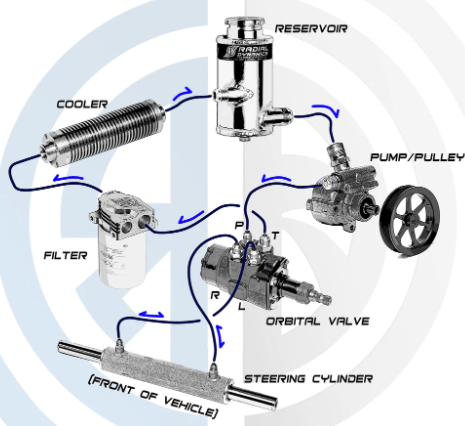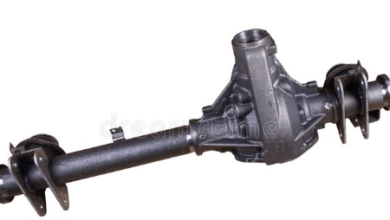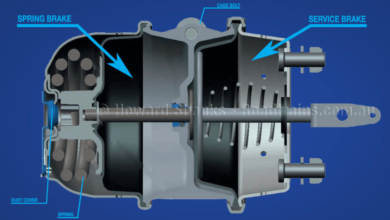Power Steering Pump Diagram – Detailed Explanation
In steering systems, we are using different kinds of technologies. One of these technologies is the power steering application. They are very useful and innovative things that make driving a car much easier. Here, we will talk about the power steering pump diagram and learn how the different steering systems work.
What is Power Steering?

First of all, we need to understand how power steering works. If we take a look at the steering systems of the different vehicles, we can see different mechanisms are available. But if there is a power steering mechanism inside these systems, there is a common system for these vehicles.
The power steering system provides extra assistive power to turn the steering wheel in one direction. The important feature is, it works only when the driver turns the steering wheel in a specific direction.
If you ever experienced that, turning the steering wheel is very hard if there is no power steering system. Even in the stationary position, turning the steering wheel is very hard. You need to apply lots of muscle power.
And engineers in automotive brands started to think about so solve this problem. They come with a power steering idea. According to this idea, we can use the hydraulic system that makes turning the steering wheel much more easy. If there is a hydraulic system, there must be a hydraulic pump that provides high-pressure fluid.
But we need to provide an amount of power to this hydraulic pump to increase the ğressure of the fluid inside it. The power comes from the engine. You know that there is a timing belt mechanism that runs the different systems of the vehicle such as oil filters, timing cams, etc. One of these systems is the hydraulic power steering pump.
Power Steering Pump Diagram

The general structure of the power steering pump system is like the above. As you see above there are different compartments are available for this system.
There is a rotor and vane system inside an oval section. This rotor and reservoir system turns with the action of the timing belt. The timing belt provides power from the engine. And when this rotor and vane system rotates, the pressure of the hydraulic fluid increases. The fluid comes from the fluid reservoir and, comes from the return hose to the reservoir. Once the rotor starts to rotate clockwise, it increases the pressure of the fluid at the pressure hose system. If the pressure is excessive, the relief valve comes into action. The relief valve relieves an excessive amount of fluid to decrease the pressure of the fluid.
This is the general working principle of the hydraulic power steering pump system.
Power Steering In Rack and Pinion Systems

According to the different steering applications, the working principle of power steering changes. It is very important to control the high-pressure fluid in the correct direction. You need to apply it accordingly.
If we take a look at the rack and pinion steering system, there is a straight rack that has teeth on it. And there is a pinion tooth that directly connects to it. The steering wheel directly connects to the pinion. Once the drşiver turns the steering wheel, the pinion starts to rotate. And with this rotation, the rack will make a horizontal motion.
Also, the rack system is connected to the tie rods which are connected to the wheel spindles. This rotation makes the wheels rotate in a specific rotation.
But, it is very hard to rotate the plain rack and pinion system. So, there is the use of the power steering pump system in modern rack and pinion applications.
As you understand above, the pump system provides high-pressure fluid to the steering system. And we use this high-pressure fluid to rotate the wheels. But how?
Pump Connection to Rack and Pinion System
The steering shaft is connected to a steering column that rotates a rotary valve. There are four connections on this rotary valve.
- From pump: High-pressure liquid comes from the pump inside the rotary valve.
- To reservoir: Excessive amount of fluid goes to the reservoir of the hydraulic pump.
- Fluid lines: The other ports of the valve provides high-pressure fluid to the rack and pinion system.
Fluid lines are connected to a piston system that will create an extra force on the rack and pinion system as you see above.
The ports of the rotary valve are activated according to the rotation direction of the steering wheel. For example, if the driver rotates the steering wheel, the high-pressure inlet port and the fluid line port that provides fluid to the left side of the piston system open. So, the high-pressure fluid goes to the left side of the piston and pushes to the right side. This will create an extra assistive force on the rack and pinion system.
This is the general working principle of the power steering system on the rack on pinion-type steering systems.
Power Steering in Recirculating Ball Systems
Also, recirculating ball systems are very common in the steering systems of different vehicles. So, they are very useful for trucks and buses in general.
If we check the general structure of this system, the rod that comes from the steering wheel is connected to a worm gear. And thişs worm gear is connected to the sector gear. Once the driver rotates the steering wheel, the worm gear moves the sector gear in a straight motion like the rack and pinion systems. This motion gives the general motion of the steering system that need. But the difference between the work gear there is a constant feed of small balls to the edges of the worm gear applications.
These small balls lower the friction between the worm gear system.
The application of these systems is completely the same as the rack and pinion systems. There is a piston and pump system that makes the motion in different directions much easier. And the steering is connected to a spool valve that opens and closes the required ports to provide different fluids.
These are the general points that we can state about power steering applications.
Electrical Power Steering
We need to be aware of the brand-new technologies of these applications. Hydraulic power steering systems brought very big ease to the driver’s life. The steering pump directly takes power from the engine which reduces the horsepower of the engine.
And engineers started to think about brand-new systems that do not use the engine power directly. And they come with electrical systems.
In an electrical power steering, there is an electric motor that provides the required assistive power to the steering system. the electrical motor must know at which time ad which direction it must provide power to the steering system.
The electric motor connected and run with the ECU system. And in general electric motors that have 12V voltages are used. And there is a steering wheel position sensor that takes information about the position of the steering wheel.
The sensor sends the position information to the ECU system. And ECU system runs the electric motor according to this input and the electric motor runs in an assistive direction.
An electric motor takes its power from the car battery directly which makes it free from the car engine. Thus the steering system will not reduce the horsepower of the engine.
Conclusion on Power Steering Pump Diagram
We explained the power steering pump diagram in a very detailed way. And also we gave extra information about the way of working the power steering in different steering systems. So, it will be much easier to understand the general working principle of these pumps and other components.
And also, explained the electric system that is commonly used in electric cars and the newest modern cars in general.
If you have knowledge and experience with the steering systems of different cars, please leave your comments below.
Your precious feedbacks are very important to us!
Also, you can find other kinds of useful posts and articles about car maintenance on fmechanic.com!
Brake Lamp Bulb Fault Problem; Causes and Solutions
Temporary Fix for Bad O2 Sensor – Detailed Guide
Ceramic Seal for Paint Protection of Your Car
Battery Acid Neutralizer – Why and How to Use?
Hydraulic Kits for Cars – Features, Pros, and Cons
FAQs About Power Steering Pump Diagram
Actually, it is hard to say about 2 types of steering pumps. Steering pumps are generally standard systems that have ports and connections. But we use these pumps in different kinds of steering systems. For example, we use them for a rack and pinion steering systems and ball circulation systems.
There are different parts of a steering pump. The first part is the pulley that we connect to the timing belt of the engine that takes the required power from the engine. And the other part is the vane and rotor system that rotates with the rotating pulley. It is connected to the rotating pulley with a shaft application. The relief valve relieves the excessive pressure. Return and pressure hose systems are the other systems that provide the hydraulic fluid from the reservoir.
There are different parts that connect these systems. The first one is the timing belt that provides the required power to the pump system. The second one is the rotary valve where the pump provides high-pressure fluid. And the third connection is the reservoir connection. It takes fluid from the reservoir.



